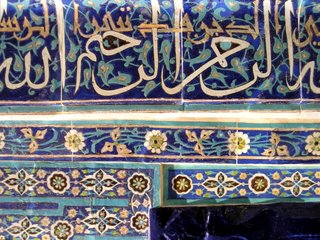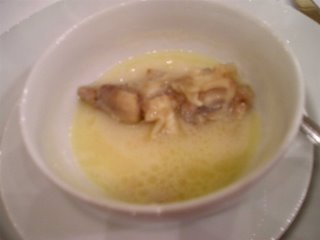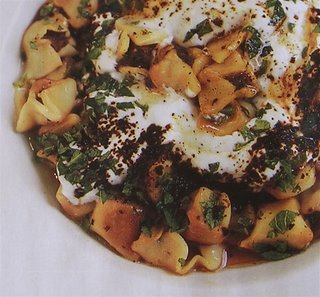
While in Istanbul, CNN Turk arranged a dinner seminar for us with Turkish food historian and champion - not to mention award-winning cookbook author - Engin Akin. She’s a passionate guide to the marvellous cuisine of her homeland.
Although Engin is fluent in English her Greece-Turkey at the Same Table isn’t available in translation (but she has a website on the way). Instead, plenty of cookbook writers have benefited from her generosity in sharing recipes. I’ve cooked recipes of hers from Paula Wolfert books, and the Clarks from London’s Moro restaurant tapped her knowledge and recipe bank for their latest cookbook, Casa Moro.
Using her considerable knowledge of the development of Turkish cuisine, Engin devised a banquet of Ottoman palace dishes and she enlightened us throughout the course of the dinner at Hünkar restaurant. A most enjoyable education.
Engin Akin's sultan’s dinner
Mezes
* Mercimek Köftesi of red lentils with red pepper, “the spice of Turkey”. Seems that paprika isn’t so Hungarian after all – the Ottomans brought it with them from Turkey when their empire expanded. Fara could almost hear her Hungarian partner, Frank, hurrumphing from Detroit.
* Pureed fava beans – both dried and fresh – with yogurt, onion and olive oil. In Turkey, fava beans are cooked in their casing. Everywhere else, the outer casing is removed.
Customarily mezes are eaten with raki – the national drink – until the main course is served. So we did the same. Raki replaced wine as the national drink, after wine was deemed to be a symbol of Christianity. Another Turkish drink, incidentally, is boza, which is made out of millet.
Soup
 Lamb trotters in a broth of olive oil, lemon and vinegar (pictured). A ceremonial Ottoman dish, and these days a popular restorative dish after too much raki. It’s also served the morning after a wedding night, presumably because that’s when one needs an energy boost most. Engin emphasised the importance of olive oil in Turkish cuisine. It is considered sacred in the Koran, and there is an entire category of Turkish cuisine for vegetables slow-cooked in olive oil. Butter is also important, having entered the diet early on when the population were nomadic animal-herders in Asia.
Lamb trotters in a broth of olive oil, lemon and vinegar (pictured). A ceremonial Ottoman dish, and these days a popular restorative dish after too much raki. It’s also served the morning after a wedding night, presumably because that’s when one needs an energy boost most. Engin emphasised the importance of olive oil in Turkish cuisine. It is considered sacred in the Koran, and there is an entire category of Turkish cuisine for vegetables slow-cooked in olive oil. Butter is also important, having entered the diet early on when the population were nomadic animal-herders in Asia.Appetiser
Hamsi pilav – a rice pilaf made with anchovies (hamsi) and currants. Black Sea anchovies are said to be the prince of fish to Turks: they put them in everything, even bread and baklava! Ordinarily I loathe anchovies but these little babies were fresh, so thankfully lacked the overpowering flavour of their heavily-salted tinned brethren which ruin many a good pizza.
Böregi (puff pastry fingers)
*Puf borek - fried and puffy
*Lady’s thigh köfte with lamb, rice and onions
*Pastirma borek – air-dried beef covered with a spicy paste of fenugreek, garlic and red peppers. The palace would make pastirma from their own cows
*Sarmas and dolmades. Sarmas means “rolled”, dolmades means “stuffed”. Both must include rice. Hang on, aren’t dolmades from Greece? Engin's explanation of how cuisines evolve from encounters with other cultures was romantically Mediterranean: “it’s a big tree which has roots going all the way around, getting nourished from where its roots are, growing new fruits”.
Manti
 The crowd favourite. Basically Turkish ravioli filled with minced lamb, covered with garlicky yogurt and browned butter with red pepper flakes. The first time I tried them in a garden restaurant overlooking the Antalya harbour, with cats weaving between my legs, manti were large pockets and the topping was nothing more than a scoop of yogurt. I still loved them. Hünkar's handmade dumplings, in contrast, were works of art. For a start, they were tiny. (Traditionally, before a Turkish girl could marry, she had to master the art of making them small enough so that 40 could fit in one soup spoon.) And butter-soft.
The crowd favourite. Basically Turkish ravioli filled with minced lamb, covered with garlicky yogurt and browned butter with red pepper flakes. The first time I tried them in a garden restaurant overlooking the Antalya harbour, with cats weaving between my legs, manti were large pockets and the topping was nothing more than a scoop of yogurt. I still loved them. Hünkar's handmade dumplings, in contrast, were works of art. For a start, they were tiny. (Traditionally, before a Turkish girl could marry, she had to master the art of making them small enough so that 40 could fit in one soup spoon.) And butter-soft. Lamb
Hünkar Beğendi, the “sultan’s favourite” dish. Grilled cubes sat on a soft blend of smoky pureed eggplant and bechamel – a surprising European enrichment. The hint of cheese made it quite rich, and worthy of a sultan. Served with white rice, the traditional signal the feast had come to an end.
Characteristically, the lamb wasn't at all spicy. Engin explained that Turks actually prefer delicate tastes (and as spices were used as medicine in the Ottoman empire they didn’t want the same taste in their food!) The spices and onions we associate with Mediterranean cuisines came from Greeks and Armenians, who opened the first hotels and restaurants in Istanbul in the 20th-century. Meals in these establishments were cooked by non-Muslims and changed the way Turks ate, with the introduction of larger chunks of meat, more butter and oil, more onions and sweetness, and cinnamon.
Dessert
*Kabak Tatlisi – pumpkins cooked in syrup and sprinkled with crushed walnuts.
*Quince with kaymak (clotted cream from buffalo milk). Slow cooked, divine.
*Helva, of which there were 26 kinds made in the palace kitchens.
*Tart, strained yogurt, topped with pekmez – boiled-down grape juice (tasted like malt)
The banquet finished with thick Turkish coffee and fluffy pashmak (what Australians call Persian fairy floss), white tufts of spun sugar with sesame oil.
No comments:
Post a Comment